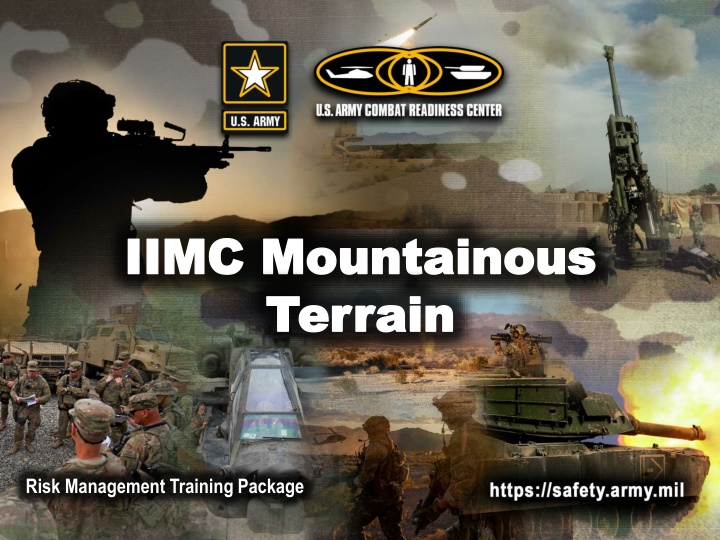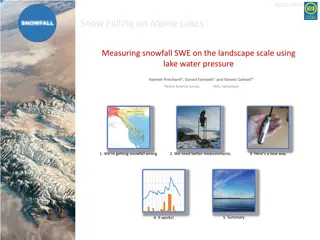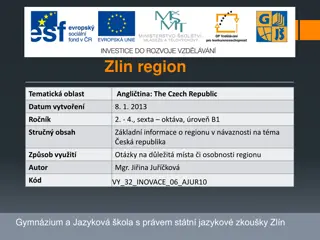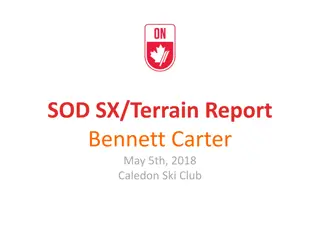
US Army Combat Readiness Center - Mountainous Terrain Mishap Report
Dive into the details of a tragic mishap during a night vision goggle evaluation in mountainous terrain where crew leadership and risk assessment failed, resulting in a fatal aircraft crash. Learn about the importance of real-time risk assessment, crew intervention, and adherence to safety protocols in challenging environments.
Download Presentation

Please find below an Image/Link to download the presentation.
The content on the website is provided AS IS for your information and personal use only. It may not be sold, licensed, or shared on other websites without obtaining consent from the author. If you encounter any issues during the download, it is possible that the publisher has removed the file from their server.
You are allowed to download the files provided on this website for personal or commercial use, subject to the condition that they are used lawfully. All files are the property of their respective owners.
The content on the website is provided AS IS for your information and personal use only. It may not be sold, licensed, or shared on other websites without obtaining consent from the author.
E N D
Presentation Transcript
US ARMY COMBAT READINESS CENTER READINESS THROUGH SAFETY IIMC Mountainous IIMC Mountainous Terrain Terrain Risk Management Training Package US Army Combat Readiness Center (USACRC) & Office of the Director of Army Safety (ODASAF)
US ARMY COMBAT READINESS CENTER READINESS THROUGH SAFETY Mishap Synopsis Mission: Conduct annual proficiency and readiness test/night vision goggle (NVG) evaluation at night under visual flight rules to include terrain flight in a mountainous environment. During the flight, the instructor pilot (IP) did not apply a real-time risk assessment and continued terrain flight while encountering a known compounded degraded visual environment (DVE). With the standardization pilot (SP) in the right-rear crew seat, leadership within the crew did not intervene and adjust mission execution based on the deteriorating weather conditions along the route. As the pilot (PI) slowed the aircraft to 30 knots indicated airspeed and was no longer able to maintain visual reference with the horizon or terrain, the IP took the controls and committed to inadvertent instrument meteorological conditions (IIMC) procedures, Aircrew Training Manual Task 1184, Respond to Inadvertent Instrument Meteorological Conditions. The IP became fixated on gaining airspeed and consequently induced an overly aggressive cyclic input that resulted in an approximate 30 degree nose-low attitude. Simultaneously, the SP began giving verbal instructions to correct the situation. The IP s action to correct pitch attitude was attempted too late. This allowed the aircraft to impact the terrain below a ridgeline, resulting in three fatalities and a destroyed aircraft. US Army Combat Readiness Center (USACRC) & Office of the Director of Army Safety (ODASAF)
US ARMY COMBAT READINESS CENTER READINESS THROUGH SAFETY Key Facts During the flight, the IP failed to apply a real-time risk assessment and continued flight in mountainous terrain while entering a known compounded DVE. - Crew leadership failed to intervene and adjust the mission. - Crew began to work through rain/snow and clouds along their route at terrain flight levels. - IP slowed the aircraft to 30 KIAS as he was unable to maintain visual reference with the horizon or terrain. - Once the IP took the controls and committed to IIMC procedures, the attempt to gain airspeed over altitude resulted in the nose-low attitude. - SP immediately began to give verbal corrective instructions to the IP. - IP began to correct his pitch input, but was too late to prevent impact. US Army Combat Readiness Center (USACRC) & Office of the Director of Army Safety (ODASAF)
US ARMY COMBAT READINESS CENTER READINESS THROUGH SAFETY What were some of the hazards the unit should have identified? Could this mishap have been prevented? Is this you? Is this your unit? Is this your chain-of-command? US Army Combat Readiness Center (USACRC) & Office of the Director of Army Safety (ODASAF)
US ARMY COMBAT READINESS CENTER READINESS THROUGH SAFETY For more information and to access all available resources, please visit the USACRC website: https://safety.army.mil/MEDIA/Exportable-Briefings US Army Combat Readiness Center (USACRC) & Office of the Director of Army Safety (ODASAF)
US ARMY COMBAT READINESS CENTER READINESS THROUGH SAFETY US Army Combat Readiness Center (USACRC) & Office of the Director of Army Safety (ODASAF)






















